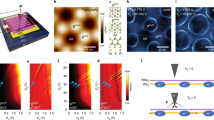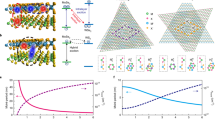Abstract
Moiré superlattices provide a highly tuneable and versatile platform to explore novel quantum phases and exotic excited states ranging from correlated insulators to moiré excitons. Scanning tunnelling microscopy has played a key role in probing microscopic behaviours of the moiré correlated ground states at the atomic scale. However, imaging of quantum excited states in moiré heterostructures remains an outstanding challenge. Here we develop a photocurrent tunnelling microscopy technique that combines laser excitation and scanning tunnelling spectroscopy to directly visualize the electron and hole distribution within the photoexcited moiré exciton in twisted bilayer WS2. The tunnelling photocurrent alternates between positive and negative polarities at different locations within a single moiré unit cell. This alternating photocurrent originates from the in-plane charge transfer moiré exciton in twisted bilayer WS2, predicted by our GW-Bethe–Salpeter equation calculations, that emerges from the competition between the electron–hole Coulomb interaction and the moiré potential landscape. Our technique enables the exploration of photoexcited non-equilibrium moiré phenomena at the atomic scale.
This is a preview of subscription content, access via your institution
Access options
Access Nature and 54 other Nature Portfolio journals
Get Nature+, our best-value online-access subscription
$29.99 / 30 days
cancel any time
Subscribe to this journal
Receive 12 print issues and online access
$259.00 per year
only $21.58 per issue
Buy this article
- Purchase on Springer Link
- Instant access to full article PDF
Prices may be subject to local taxes which are calculated during checkout




Similar content being viewed by others
Data availability
The data supporting the findings of this study are included in the main text and in the Supplementary Information, and are also available at https://github.com/HongyuanLiCMP/Imaging-Moir-Excited-States-with-Photocurrent-Tunneling-Microscopy.
References
Li, H. et al. Imaging two-dimensional generalized Wigner crystals. Nature 597, 650–654 (2021).
Regan, E. C. et al. Mott and generalized Wigner crystal states in WSe2/WS2 moiré superlattices. Nature 579, 359–363 (2020).
Xu, Y. et al. Correlated insulating states at fractional fillings of moiré superlattices. Nature 587, 214–218 (2020).
Huang, X. et al. Correlated insulating states at fractional fillings of the WS2/WSe2 moiré lattice. Nat. Phys. 17, 715–719 (2021).
Xie, Y.-M., Zhang, C.-P., Hu, J.-X., Mak, K. F. & Law, K. T. Valley-polarized quantum anomalous Hall state in moiré MoTe2/WSe2 heterobilayers. Phys. Rev. Lett. 128, 026402 (2022).
Li, T. et al. Quantum anomalous Hall effect from intertwined moiré bands. Nature 600, 641–646 (2021).
Jin, C. et al. Observation of moiré excitons in WSe2/WS2 heterostructure superlattices. Nature 567, 76–80 (2019).
Naik, M. H. et al. Intralayer charge-transfer moiré excitons in van der Waals superlattices. Nature 609, 52–57 (2022).
Seyler, K. L. et al. Signatures of moiré-trapped valley excitons in MoSe2/WSe2 heterobilayers. Nature 567, 66–70 (2019).
Tran, K. et al. Evidence for moiré excitons in van der Waals heterostructures. Nature 567, 71–75 (2019).
Choi, Y. et al. Correlation-driven topological phases in magic-angle twisted bilayer graphene. Nature 589, 536–541 (2021).
Kerelsky, A. et al. Maximized electron interactions at the magic angle in twisted bilayer graphene. Nature 572, 95–100 (2019).
Jiang, Y. et al. Charge order and broken rotational symmetry in magic-angle twisted bilayer graphene. Nature 573, 91–95 (2019).
Wong, D. et al. Cascade of electronic transitions in magic-angle twisted bilayer graphene. Nature 582, 198–202 (2020).
Xie, Y. et al. Spectroscopic signatures of many-body correlations in magic-angle twisted bilayer graphene. Nature 572, 101–105 (2019).
Cao, Y. et al. Correlated insulator behaviour at half-filling in magic-angle graphene superlattices. Nature 556, 80–84 (2018).
Li, H. et al. Mapping charge excitations in generalized Wigner crystals. Preprint at arXiv https://doi.org/10.48550/arXiv.2209.12830 (2022).
Kim, H. et al. Evidence for unconventional superconductivity in twisted trilayer graphene. Nature 606, 494–500 (2022).
Oh, M. et al. Evidence for unconventional superconductivity in twisted bilayer graphene. Nature 600, 240–245 (2021).
Cao, Y. et al. Unconventional superconductivity in magic-angle graphene superlattices. Nature 556, 43–50 (2018).
Karni, O. et al. Structure of the moiré exciton captured by imaging its electron and hole. Nature 603, 247–252 (2022).
Wang, L. et al. Correlated electronic phases in twisted bilayer transition metal dichalcogenides. Nat. Mater. 19, 861–866 (2020).
Yankowitz, M. et al. Tuning superconductivity in twisted bilayer graphene. Science 363, 1059–1064 (2019).
Li, H. et al. Imaging local discharge cascades for correlated electrons in WS2/WSe2 moiré superlattices. Nat. Phys. https://doi.org/10.1038/s41567-021-01324-x (2021).
Imai-Imada, M. et al. Orbital-resolved visualization of single-molecule photocurrent channels. Nature 603, 829–834 (2022).
Wang, L., Xia, Y. & Ho, W. Atomic-scale quantum sensing based on the ultrafast coherence of an H2 molecule in an STM cavity. Science 376, 401–405 (2022).
Qiu, X., Nazin, G. & Ho, W. Vibrationally resolved fluorescence excited with submolecular precision. Science 299, 542–546 (2003).
Ćavar, E. et al. Fluorescence and phosphorescence from individual C60 molecules excited by local electron tunneling. Phys. Rev. Lett. 95, 196102 (2005).
Bolotov, L., Tada, T., Poborchii, V., Fukuda, K. & Kanayama, T. Spatial distribution of photocurrent in Si stripes under tilted illumination measured by multimode scanning probe microscopy. Jpn J. Appl. Phys. 51, 088005 (2012).
Yamamoto, H. Y. H., Kamiya, I. K. I. & Takahashi, T. T. T. Photoinduced current properties of InAs-covered GaAs studied by scanning tunneling microscopy. Jpn J. Appl. Phys. 38, 3871 (1999).
Takeuchi, O. et al. Probing subpicosecond dynamics using pulsed laser combined scanning tunneling microscopy. Appl. Phys. Lett. 85, 3268–3270 (2004).
McEllistrem, M., Haase, G., Chen, D. & Hamers, R. Electrostatic sample–tip interactions in the scanning tunneling microscope. Phys. Rev. Lett. 70, 2471 (1993).
Kochanski, G. P. & Bell, R. STM measurements of photovoltage on Si(111) and Si(111):Ge. Surf. Sci. 273, L435–L440 (1992).
Matthes, T. W. et al. Investigation of photoinduced tunneling current and local surface photovoltage by STM. Appl. Surf. Sci. 123, 187–191 (1998).
Li, H. et al. Imaging moiré flat bands in three-dimensional reconstructed WSe2/WS2 superlattices. Nat. Mater. 20, 945–950 (2021).
Naik, M. H. & Jain, M. Ultraflatbands and shear solitons in moiré patterns of twisted bilayer transition metal dichalcogenides. Phys. Rev. Lett. 121, 266401 (2018).
Naik, M. H., Kundu, S., Maity, I. & Jain, M. Origin and evolution of ultraflat bands in twisted bilayer transition metal dichalcogenides: realization of triangular quantum dots. Phys. Rev. B 102, 075413 (2020).
Wu, F., Lovorn, T. & MacDonald, A. H. Topological exciton bands in moiré heterojunctions. Phys. Rev. Lett. 118, 147401 (2017).
Jin, C. et al. Ultrafast dynamics in van der Waals heterostructures. Nat. Nanotechnol. 13, 994–1003 (2018).
Wang, H., Zhang, C. & Rana, F. Ultrafast dynamics of defect-assisted electron–hole recombination in monolayer MoS2. Nano Lett. 15, 339–345 (2015).
Shi, H. et al. Exciton dynamics in suspended monolayer and few-layer MoS2 2D crystals. ACS Nano 7, 1072–1080 (2013).
Jauregui, L. A. et al. Electrical control of interlayer exciton dynamics in atomically thin heterostructures. Science 366, 870–875 (2019).
Hybertsen, M. S. & Louie, S. G. Electron correlation in semiconductors and insulators: band gaps and quasiparticle energies. Phys. Rev. B 34, 5390–5413 (1986).
Rohlfing, M. & Louie, S. G. Electron–hole excitations in semiconductors and insulators. Phys. Rev. Lett. 81, 2312–2315 (1998).
Wang, L. et al. One-dimensional electrical contact to a two-dimensional material. Science 342, 614–617 (2013).
Acknowledgements
This work was primarily funded by the United States Department of Energy, Office of Science, Office of Basic Energy Sciences, Materials Sciences and Engineering Division under contract no. DE-AC02-05CH11231 (van der Waals heterostructure programme KCFW16) for device fabrication, STM spectroscopy and force field calculations for structural reconstructions. The Center for Computational Study of Excited-State Phenomena in Energy Materials (C2SEPEM) at Lawrence Berkeley National Laboratory, supported by the United States Department of Energy, Office of Science, Basic Energy Sciences, Materials Sciences and Engineering Division under contract no. DE-AC02-05CH11231, as part of the Computational Materials Sciences Program, provided advanced codes and experimental support for optical measurements. The Theory of Materials Program (KC2301) funded by the DOE Office of Science, Basic Energy Sciences, Materials Sciences and Engineering Division under contract DE-AC02-05CH11231, provided resources to develop the PUMP approach and analysis of the moiré excitons. Computational resources were provided by the National Energy Research Scientific Computing Center (NERSC), which is supported by the DOE Office of Science under contract DE-AC02-05CH11231, and Frontera at TACC, which is supported by the National Science Foundation under grant OAC-1818253. Support was also provided by National Science Foundation Award DMR-2221750 (surface preparation). S.T. acknowledges support from DOE-SC0020653, NSF DMR 2111812, NSF DMR 1552220, NSF 2052527, DMR 1904716 and NSF CMMI 1933214 for WS2 bulk crystal growth and analysis. K.W. and T.T. acknowledge support from JSPS KAKENHI (grant nos. 19H05790, 20H00354 and 21H05233). We thank Y. W. Choi, S. Kundu and J. Ruan for discussions.
Author information
Authors and Affiliations
Contributions
S.G.L., M.F.C. and F.W. conceived the project. H.L. and Z.X. performed the STM/STS and PTM measurements, M.H.N. and F.H.d.J. formulated the generalized PUMP method, and M.H.N., W.K. and Z.L. performed the ab initio GW-BSE calculations. H.L. and Z.X. fabricated the heterostructure device. R.S., R.B. and S.T. grew the WS2 crystals. K.W. and T.T. grew the hBN single crystal. All authors discussed the results and wrote the manuscript.
Corresponding authors
Ethics declarations
Competing interests
The authors declare no competing interests.
Peer review
Peer review information
Nature Materials thanks the anonymous reviewers for their contribution to the peer review of this work.
Additional information
Publisher’s note Springer Nature remains neutral with regard to jurisdictional claims in published maps and institutional affiliations.
Supplementary information
Supplementary Information
Supplementary Figs. 1–13 and discussion.
Rights and permissions
Springer Nature or its licensor (e.g. a society or other partner) holds exclusive rights to this article under a publishing agreement with the author(s) or other rightsholder(s); author self-archiving of the accepted manuscript version of this article is solely governed by the terms of such publishing agreement and applicable law.
About this article
Cite this article
Li, H., Xiang, Z., Naik, M.H. et al. Imaging moiré excited states with photocurrent tunnelling microscopy. Nat. Mater. (2024). https://doi.org/10.1038/s41563-023-01753-4
Received:
Accepted:
Published:
DOI: https://doi.org/10.1038/s41563-023-01753-4



